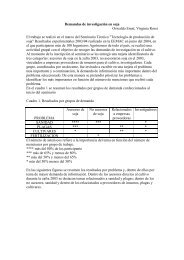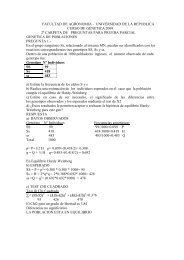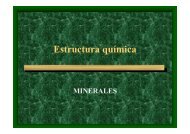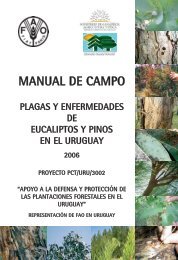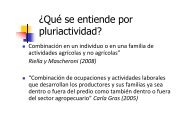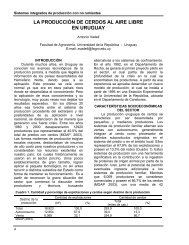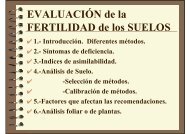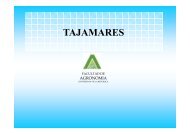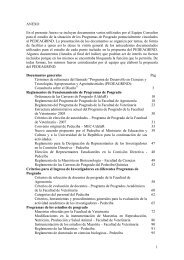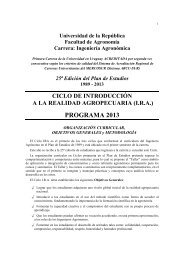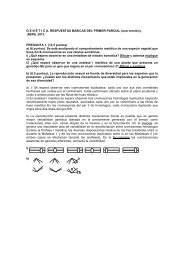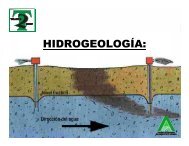Presentación Invernada - Facultad de Agronomía
Presentación Invernada - Facultad de Agronomía
Presentación Invernada - Facultad de Agronomía
Create successful ePaper yourself
Turn your PDF publications into a flip-book with our unique Google optimized e-Paper software.
<strong>Facultad</strong> <strong>de</strong> <strong>Agronomía</strong><br />
Durazno, Agosto 2007
Sistema <strong>de</strong> producción que se sustenta en dos<br />
pilares :<br />
ASPECTOS PRODUCTIVOS<br />
Eficiencia <strong>de</strong> producción<br />
ASPECTOS ASPECTOS ECONÓMICOS<br />
Habilidad comercial
1- Eficiencia <strong>de</strong> producción<br />
La primera condición para <strong>de</strong>sarrollar una<br />
invernada eficiente es :<br />
PARTIR DE UN<br />
TERNERO<br />
BIEN CRIADO<br />
Asegura la manifestación <strong>de</strong> las ondas <strong>de</strong> crecimiento
incremento incremento <strong>de</strong> <strong>de</strong> peso peso<br />
por por unidad unidad <strong>de</strong> <strong>de</strong> tiempo tiempo<br />
Animal Precoz o alto plano nutritivo<br />
I II III IV<br />
CONCEPCION MADUREZ<br />
incremento incremento <strong>de</strong> <strong>de</strong> peso peso<br />
por por unidad unidad <strong>de</strong> <strong>de</strong> tiempo tiempo<br />
Animal no precoz o bajo plano nutritivo<br />
I II III IV<br />
CONCEPCION MADUREZ
Proporciones típicas <strong>de</strong> hueso, músculo y grasa en<br />
reses <strong>de</strong> animales <strong>de</strong> carne a diferentes eda<strong>de</strong>s<br />
3 meses<br />
8 meses<br />
Edad<br />
2 años 9 meses<br />
3 años 3 meses<br />
% Hueso<br />
26<br />
18<br />
13<br />
10<br />
% Músculo<br />
67<br />
66<br />
49<br />
47<br />
% Grasa<br />
7<br />
16<br />
38<br />
43
2- Eficiencia <strong>de</strong> producción<br />
Producción Kgs. Kgs.<br />
/ há. há.<br />
= nº animales x ganancia individual / Área total<br />
Kg/animal<br />
Dotación<br />
Kg/Há.
Opciones <strong>de</strong> alimentación en invernada<br />
PASTURAS<br />
VOLUMINOSOS<br />
CONCENTRADOS
Pasturas Alimento más barato – Sustentabilidad en el tiempo<br />
Alimento<br />
Campo Natural<br />
Pra<strong>de</strong>ra<br />
Ver<strong>de</strong>o invierno<br />
Ver<strong>de</strong>o verano<br />
Fardos bueno<br />
Silo maiz<br />
Grano sorgo<br />
Grano maíz<br />
Ración<br />
Afrechillo<br />
% MS<br />
20<br />
18<br />
17<br />
20<br />
85<br />
30<br />
88<br />
88<br />
89<br />
89<br />
Costo U$S/kg MS<br />
------<br />
0.018<br />
0.03<br />
0.04<br />
0.07<br />
0.06<br />
0.14<br />
0.19<br />
0.22<br />
0.18
Ganancia diaria sobre pasturas<br />
<strong>de</strong>sbalance<br />
cantidad<br />
óptimo<br />
calidad<br />
Oto. Inv. Prim. Ver.
Pasturas<br />
CAMPO NATURAL<br />
MEJ. EXTENSIVOS<br />
PRADERAS<br />
VERDEOS<br />
Alimento más barato – Sustentabilidad en el tiempo<br />
DOTACIÓN<br />
Baja<br />
Media<br />
Alta<br />
Alta<br />
GANANCIA<br />
INDIVIDUAL<br />
Media<br />
Media<br />
Media-Alta<br />
Alta<br />
ESTABILIDAD<br />
ENTRE<br />
ESTACIONES<br />
Baja<br />
Baja-Media<br />
Media<br />
Media-Alta<br />
EDAD DE<br />
TERMINACIÓN<br />
(AÑOS)<br />
+ <strong>de</strong> 3<br />
3<br />
2 ½ - 3<br />
2 ½
Reservas Forrajeras <strong>de</strong> uso más frecuente :<br />
SILOS<br />
Maíz / Pra<strong>de</strong>ra<br />
HENOS<br />
Pra<strong>de</strong>ra / Moha
Voluminosos<br />
Permiten una mayor estabilidad en el sistema - “seguro <strong>de</strong> producción”<br />
Permiten racionar el forraje <strong>de</strong> calidad<br />
Mantienen carga<br />
Evitan zafralidad <strong>de</strong> las ventas<br />
Regulan el volumen <strong>de</strong> forraje<br />
(exce<strong>de</strong>nte primaveral)<br />
primaveral
Uso estratégico suplementos<br />
Dieta Ganancia Carga Con. Silo Con. past. Consumo<br />
(gr/día) (a/há) (kg MS/día) (kg MS/día) (% PV)<br />
Sólo silo maíz 255 -- 6 -- 1.8<br />
Silo + 2 hs past 795 24 4.5 2.5 1.9<br />
Silo + 4 hs past 843 12 3.5 5.5 2.4<br />
Sólo pastura 949 6 -- 11 2.9
SILOS GRANO HÚMEDO<br />
Maíz / Sorgo
Concentrados<br />
Mantienen carga<br />
Corrigen <strong>de</strong>ficiencias <strong>de</strong> dieta<br />
Energéticos<br />
Proteicos
Caracterización <strong>de</strong> distintas opciones <strong>de</strong> invernada<br />
CAMPO NATURAL<br />
MEJ. EXTENSIVOS<br />
PRADERAS<br />
PRADERA + FARDOS<br />
PRADERA + VERDEOS +<br />
FARDOS<br />
PRADERA + VERDEOS +<br />
FARDOS + GRANO<br />
Dotación<br />
Baja<br />
Media<br />
Alta<br />
Alta<br />
Alta<br />
Alta<br />
Ganancia <strong>de</strong> peso<br />
(grs/dia)<br />
Media<br />
Media<br />
Media-Alta<br />
Media-Alta<br />
Alta<br />
Alta<br />
Estabilidad entre<br />
estaciones<br />
Baja<br />
Baja-Media<br />
Media<br />
Media-Alta<br />
Alta<br />
Alta<br />
Edad terminación<br />
(meses)<br />
+ <strong>de</strong> 36<br />
Aprox. 36<br />
30 a 36<br />
30 a 36<br />
30 o menos<br />
- <strong>de</strong> 30
Potencial forrajero para producir carne<br />
RECURSOS<br />
CAMPO NATURAL REGULAR *<br />
CAMPO NATURAL BUENO **<br />
CAMPO NATURAL MEJORADO<br />
PRADERA (suplementación<br />
( suplementación)<br />
VERDEO (suplementación<br />
( suplementación)<br />
( * ) basalto o cristalino medio o superficial<br />
( ** ) basalto y cristalino profundo, litoral oeste y sur<br />
GANANCIA DIARIA<br />
(grs grs)<br />
250<br />
350<br />
600<br />
700<br />
800<br />
PRODUCCIÓN ANUAL<br />
(kg kg / há) há<br />
100<br />
150<br />
200<br />
250<br />
300<br />
Adaptado <strong>de</strong> Ing. Guillermo Pigurina (Sist. <strong>de</strong> recría e invernada en Uruguay)
Oferta<br />
Pasto %<br />
PV<br />
1,5<br />
3<br />
Efecto Suplementación<br />
Consumo<br />
Grano<br />
kg/día<br />
0<br />
2<br />
4<br />
0<br />
2<br />
4<br />
Ut.Forraje<br />
%<br />
82<br />
77<br />
70<br />
57<br />
58<br />
48<br />
Ganancia<br />
gr/día<br />
173<br />
810<br />
840<br />
904<br />
1045<br />
958<br />
Ef.conversión kg<br />
grano/kg PV<br />
3<br />
6<br />
14<br />
74
• OFERTA : Cantidad<br />
PRESIÓN PASTOREO (% PV)<br />
% UTILIZACIÓN<br />
GANANCIA (GRS / DÍA)<br />
EFECTO SUPLEMENTO<br />
1.5<br />
80<br />
226<br />
Alto<br />
3<br />
66<br />
1020<br />
0
• OFERTA : Calidad<br />
DIGESTIBILIDAD<br />
CONSUMO ( % PV )<br />
CONSUMO (kg MS / día)<br />
GANANCIA (grs / día)<br />
50<br />
1.9<br />
5.9<br />
11<br />
60<br />
2.3<br />
7<br />
400<br />
70<br />
2.45<br />
7.3<br />
980
Claves <strong>de</strong>l manejo nutricional para producción <strong>de</strong> carne<br />
OFERTA Cantidad<br />
Calidad<br />
DEMANDA Requerimientos<br />
(mantenimiento, producción)<br />
BALANCE Oferta/<strong>de</strong>manda
• DEMANDA : Requerimientos animales
PRACTICA DE CAMPO PARA MONITOREAR<br />
LA ALIMENTACION<br />
Las heces están compuestas por restos <strong>de</strong> alimentos que no<br />
fueron utilizados, porque eran indigestibles (por ejemplo, fibra<br />
muy lignificada) o porque pasaron muy rápidamente sin<br />
tiempo <strong>de</strong> ser atacados, como por ejemplo los forrajes muy<br />
tiernos.<br />
Un estudio <strong>de</strong> la bosta en los potreros y corrales <strong>de</strong> espera o<br />
<strong>de</strong> alimentación, pue<strong>de</strong> ayudar a interpretar y corregir<br />
problemas <strong>de</strong> alimentación
Dieta :<br />
Consistencia “firme”<br />
forma piramidal<br />
Demasiada fibra entera <strong>de</strong> calidad regular y largo<br />
tiempo <strong>de</strong> retención en el rumen.<br />
Provoca efecto <strong>de</strong> llenado ruminal y conduce a<br />
menores consumos.<br />
Dieta :<br />
Consistencia blanda<br />
aplanada, salpica<br />
Deficiente en fibra, principalmente FDN efectiva.<br />
Refleja altos consumos <strong>de</strong>bidos a altas tasas <strong>de</strong><br />
digestión <strong>de</strong>l alimento y alta velocidad <strong>de</strong> pasaje.<br />
Es una condición <strong>de</strong> “alerta”<br />
Consistencia i<strong>de</strong>al menos firme y con<br />
una <strong>de</strong>presión al centro<br />
Dieta :<br />
Correcta cantidad y calidad <strong>de</strong> la fibra <strong>de</strong>tergente neutra.<br />
Este tipo <strong>de</strong> heces indica a<strong>de</strong>cuados consumos y dieta<br />
balanceada, por lo tanto buena respuesta en producción.<br />
Consistencia chirla, acuosa forma plana,<br />
cae en chorros<br />
Dieta :<br />
Con severo <strong>de</strong>sbalance nutricional.<br />
Refleja un déficit pronunciado <strong>de</strong> fibra, hay disturbios en el<br />
metabolismo mineral y esto causa alteraciones en el<br />
balance hídrico <strong>de</strong>l cuerpo. Es frecuente en animales<br />
pastoreando avenas tiernas como principal componente <strong>de</strong><br />
la dieta.<br />
Es una condición <strong>de</strong> “alerta roja”
Aspectos económicos
Relación compra/venta<br />
(Peso <strong>de</strong> venta x precio <strong>de</strong> venta) – (Peso <strong>de</strong> compra x precio <strong>de</strong> compra)<br />
Peso <strong>de</strong> venta – Peso <strong>de</strong> compra<br />
Ejemplo 1 Ejemplo 2<br />
Compra terneros 150 kg a U$S 1.20/ kg Compra novillos 300 kg a U$S 0,95/ kg<br />
Venta novillos 450 kg a 1/ kg Venta novillos 450 kg a U$S 1 / kg<br />
Relación flaco/gordo: 1.20 Relación flaco/gordo: 0,95<br />
Valor <strong>de</strong>l kg agregado: U$S 0.90 Valor <strong>de</strong>l kg agregado: U$S 1,1
Relación compra/venta<br />
Mayor producción física F/G = 1<br />
Compra animales livianos F/G > 1<br />
<strong>Invernada</strong>s cortas F/G < 1



